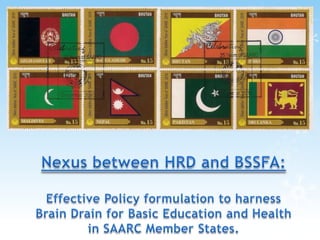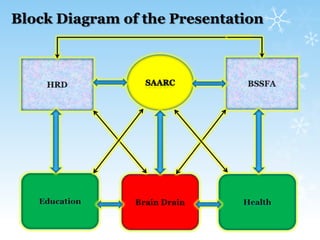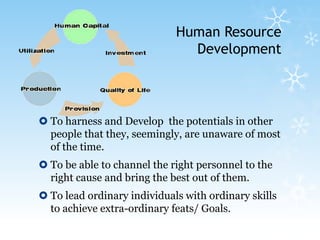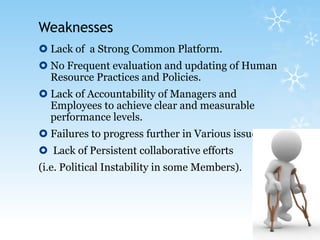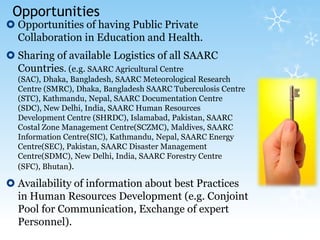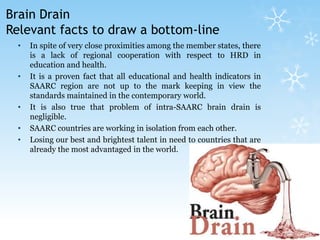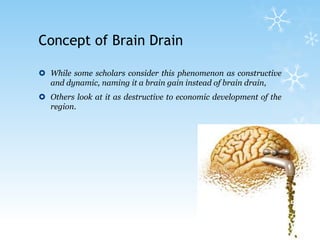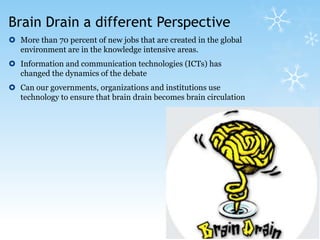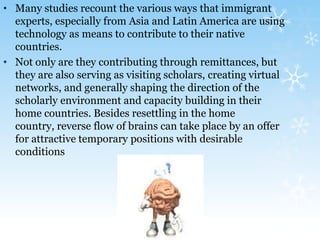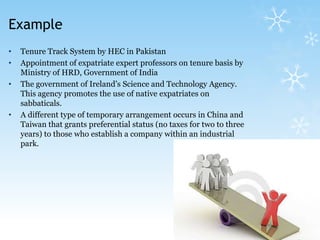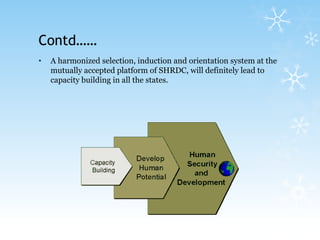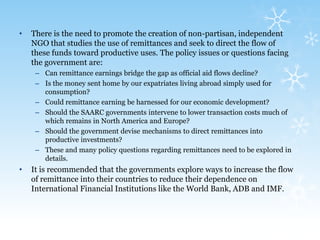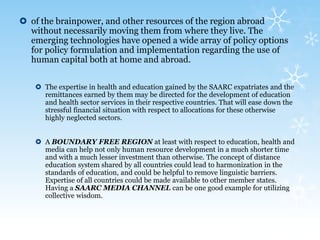Nexus Between Hrd And Bssfa (Revised)
- 2. Nexus between HRD and BSSFA:Effective Policy formulation to harness Brain Drain for Basic Education and Health in SAARC Member States.
- 3. Block Diagram of the Presentation SAARCBSSFAHRDEducationBrain DrainHealth
- 4. Human Resource DevelopmentTo harness and Develop the potentials in other people that they, seemingly, are unaware of most of the time. To be able to channel the right personnel to the right cause and bring the best out of them. To lead ordinary individuals with ordinary skills to achieve extra-ordinary feats/ Goals.
- 5. Strengths Many Resources materials, activities are available e.g. manuals of trainings, guides, projects etc.Experienced Workforce is available in SAARC regions and it is the team work required by the members states.Adequate Logistics are available in each SAARC state.HRD in SAARC Region
- 6. Weaknesses Lack of a Strong Common Platform.No Frequent evaluation and updating of Human Resource Practices and Policies.Lack of Accountability of Managers and Employees to achieve clear and measurable performance levels.Failures to progress further in Various issues Lack of Persistent collaborative efforts (i.e. Political Instability in some Members).
- 7. Opportunities Opportunities of having Public Private Collaboration in Education and Health.Sharing of available Logistics of all SAARC Countries. (e.g. SAARC Agricultural Centre (SAC), Dhaka, Bangladesh, SAARC Meteorological Research Centre (SMRC), Dhaka, Bangladesh SAARC Tuberculosis Centre (STC), Kathmandu, Nepal, SAARC Documentation Centre (SDC), New Delhi, India, SAARC Human Resources Development Centre (SHRDC), Islamabad, Pakistan, SAARC Costal Zone Management Centre(SCZMC), Maldives, SAARC Information Centre(SIC), Kathmandu, Nepal, SAARC Energy Centre(SEC), Pakistan, SAARC Disaster Management Centre(SDMC), New Delhi, India, SAARC Forestry Centre (SFC), Bhutan).Availability of information about best Practices in Human Resources Development (e.g. Conjoint Pool for Communication, Exchange of expert Personnel).
- 8. ThreatsPolicies are not sustainable on various issues (i.e. Terrorism, Security, Diplomatic Links)Governments are shifting towards Privatization like PTCL, Steel Mill in Pakistan etc. without proper regulatory framework.Job Security (i.e. Contractual Jobs, Lack of Long terms commitments.)
- 9. Basic social services for all (BASFA)Benefits and facilities such as education, food subsidies, health care, and subsidized housing provided by a government/ NGOs/ CSOs to improve the life and living conditions of the children, disabled, the elderly, and the poor in the national community.
- 10. Brain DrainRelevant facts to draw a bottom-lineIn spite of very close proximities among the member states, there is a lack of regional cooperation with respect to HRD in education and health.
- 11. It is a proven fact that all educational and health indicators in SAARC region are not up to the mark keeping in view the standards maintained in the contemporary world.
- 12. It is also true that problem of intra-SAARC brain drain is negligible.
- 13. SAARC countries are working in isolation from each other.
- 14. Losing our best and brightest talent in need to countries that are already the most advantaged in the world.Concept of Brain DrainWhile some scholars consider this phenomenon as constructive and dynamic, naming it a brain gain instead of brain drain,Others look at it as destructive to economic development of the region.
- 15. Brain Drain Substantial cost involved in educating these professionals, and lost investment and benefits due to lack of specialists to develop the country.
- 16. Brain circulation - the cycle of moving abroad to study, then taking a job abroad and later returning home to take advantage of a good opportunity.
- 17. It also entails the exchange of brains or ideas among intellectuals at home with their counterparts in the developed countries.More than 70 percent of new jobs that are created in the global environment are in the knowledge intensive areas.Information and communication technologies (ICTs) has changed the dynamics of the debateCan our governments, organizations and institutions use technology to ensure that brain drain becomes brain circulationBrain Drain a different Perspective
- 18. Many studies recount the various ways that immigrant experts, especially from Asia and Latin America are using technology as means to contribute to their native countries.
- 19. Not only are they contributing through remittances, but they are also serving as visiting scholars, creating virtual networks, and generally shaping the direction of the scholarly environment and capacity building in their home countries. Besides resettling in the home country, reverse flow of brains can take place by an offer for attractive temporary positions with desirable conditionsExampleTenure Track System by HEC in Pakistan
- 20. Appointment of expatriate expert professors on tenure basis by Ministry of HRD, Government of India
- 21. The government of Ireland’s Science and Technology Agency. This agency promotes the use of native expatriates on sabbaticals.
- 22. A different type of temporary arrangement occurs in China and Taiwan that grants preferential status (no taxes for two to three years) to those who establish a company within an industrial park. ExamplesAccepting a two to three year appointment in the home country while maintaining ties with the United States. (Professor from Hong Kong University of Science and Technology )Or experts remain abroad but establish and maintain a long-term relationship with researchers in their home country through periodic visits, international conferences, workshops, short courses at their home institutions, and collaborative researches. Networking of experts abroad with experts at home. Columbia “lost” scientists and engineers working abroad to reverse brain drain to brain gain. ĚýThailand’s “The Reverse Brain Drain Project,” is designed to make the immigrant nationals become part of the nation building process without uprooting them from their bases elsewhere.
- 23. POSSIBILITIES FOR EFFECTIVE POLICY FORMULATIONSĚýWhether experts from SAARC working abroad eventually contribute to region’s development depends to some extent on the government policies or initiatives on this issue and its commitments to engaging highly skilled professionals in nation building.
- 24. Policy options for dealing with the issue of brain drain can be grouped into
- 25. the return option and
- 26. the Diaspora option. Strategies based on the return option may include: Political stability, not an easy matter to achieve and maintain, Sound economic policies leading to a viable private sector development, and The institution of a fair and friendly regulatory environment.
- 27. Contd……A harmonized selection, induction and orientation system at the mutually accepted platform of SHRDC, will definitely lead to capacity building in all the states. The return option also calls for the governments to initiate outreach to the Diasporas, for example, offering incentives such as
- 28. access to reliable quality health services.
- 31. housing,
- 33. cash bonuses, and Possible Future Options? Rather than being viewed as disloyal and unpatriotic, should be valued for creating bridges between their respective countries and Europe, and USA,
- 34. National policy dialogues and workshops on brain circulation using it to identify appropriate expertise.
- 35. A regional agency to promote a link and connection among its expatriate community overseas as well as their local counterparts.
- 36. This agency (SAARC Expatriate Facilitation Centre - SEFC) responsible for promoting the use of ICT as a tool in forging stronger cooperation and collaboration between the homeland and the Diaspora. The facility will act not only as Database of the expatriates from the region, but also will share these information with all members in order to enable them to locate and make use of their lost human potentials.
- 37. Another policy area that we would like to explore in greater detail is remittances. There is the need to promote the creation of non-partisan, independent NGO that studies the use of remittances and seek to direct the flow of these funds toward productive uses. The policy issues or questions facing the government are:
- 38. Can remittance earnings bridge the gap as official aid flows decline?
- 39. Is the money sent home by our expatriates living abroad simply used for consumption?
- 40. Could remittance earning be harnessed for our economic development?
- 41. Should the SAARC governments intervene to lower transaction costs much of which remains in North America and Europe?
- 42. Should the government devise mechanisms to direct remittances into productive investments?
- 43. These and many policy questions regarding remittances need to be explored in details.
- 44. It is recommended that the governments explore ways to increase the flow of remittance into their countries to reduce their dependence on International Financial Institutions like the World Bank, ADB and IMF. Conclusions With the rapidly changing world, people are citizens of the global village now, and many of their foreign contacts are virtual than physical. It is neither logical nor possible to stop the use of our human capital abroad. It would therefore be wiser to frame policies with changed realities than to rigidly stick to our classical concept of geographical boundaries. Those nations who fail to understand the message of time will vanish into the pages of history.
- 45. It would not be an over emphasis to say that in addressing the problem of brain drain, the government policies should focus on fostering the :utilization, contribution, and exploitation
- 46. of the brainpower, and other resources of the region abroad without necessarily moving them from where they live. The emerging technologies have opened a wide array of policy options for policy formulation and implementation regarding the use of human capital both at home and abroad.The expertise in health and education gained by the SAARC expatriates and the remittances earned by them may be directed for the development of education and health sector services in their respective countries. That will ease down the stressful financial situation with respect to allocations for these otherwise highly neglected sectors.A BOUNDARY FREE REGION at least with respect to education, health and media can help not only human resource development in a much shorter time and with a much lesser investment than otherwise. The concept of distance education system shared by all countries could lead to harmonization in the standards of education, and could be helpful to remove linguistic barriers. Expertise of all countries could be made available to other member states. Having a SAARC MEDIA CHANNEL can be one good example for utilizing collective wisdom.
- 48. Thank You


